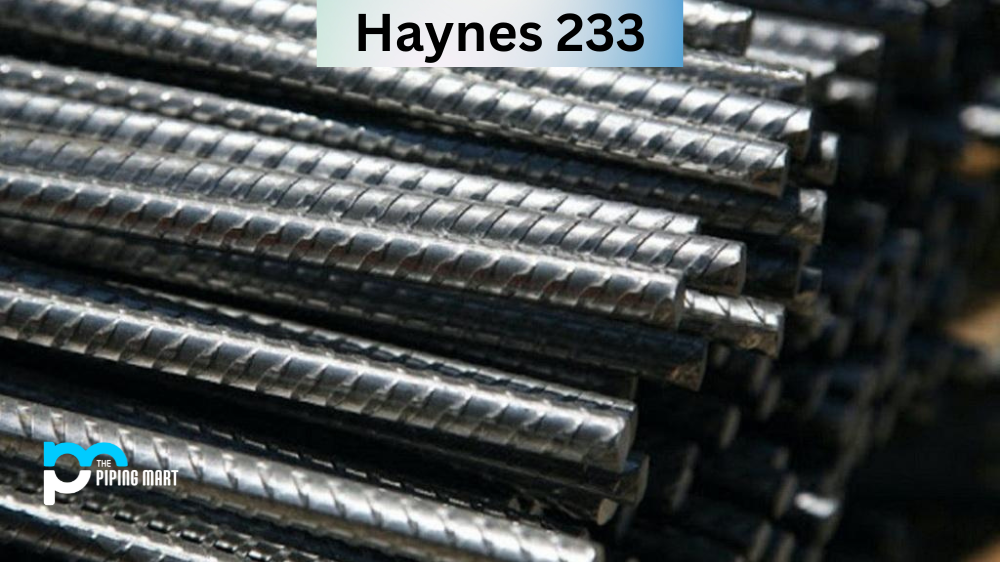Haynes 233 is a nickel-chromium-tungsten alloy that has been used in a variety of industrial applications due to its unique composition, mechanical properties, and physical properties. In this blog post, we will discuss the composition of Haynes 233, its mechanical properties, physical properties, uses, and corrosion resistance.
Haynes 233 Composition
Haynes 233 is made up of 19% chromium, 13% tungsten, 5% molybdenum, 2% silicon, and 3% cobalt. It also contains trace amounts of other metals, such as manganese and iron. This combination of elements gives it excellent high-temperature strength as well as good corrosion resistance to many acids and alkalis.
| Fe | Al | Ti | Mo | Co | Cr | Ni |
| 1.5 | 3.3 | 0.5 | 7.5 | 19 | 19 | 48 |
| Zr | Y | W | Ta | C | Si | Mn |
| 0.03 | 0.025 | 0.3 | 0.5 | 0.1 | 0.2 | 0.4 |
Haynes 233 Mechanical Properties
The mechanical properties of grade 233 make it an ideal choice for many high-temperature applications. It has an ultimate tensile strength of over 75 ksi (537 MPa) which makes it one of the strongest alloys available. It also has a yield strength of over 55 ksi (379 MPa) which means it can handle high levels of force without deforming or breaking. Additionally, its elongation at break is 13%, meaning it can be stretched or bent before fracturing or cracking.
Haynes 233 Physical Properties
The physical properties of alloy 233 give it several advantages over other materials in certain industrial applications. For example, its density comes in at 0.289 lb/in3 (8 gm/cc), which is significantly lower than other metals such as stainless steel or aluminium alloy. This makes it an ideal material for components that require lightweight construction without sacrificing strength or durability. Additionally, its thermal expansion coefficient is 8 x 10-6 per K, which is much lower than most metals making it better suited for temperature extremes where expansion must be kept to a minimum.
| Temperature (°F) | Specific Heat (BTU/lb-°F) |
Thermal Conductivity (BTU-in./ft2-hr.-°F) |
Thermal Diffusivity (ft2/h) |
Electrical Resistivity (microhms-in.) |
Mean Coefficient of Thermal Expansion (min/in-°F) |
| 1000 | 0.127 | 125 | 0.162 | 53.5 | 7.5 |
| 1200 | 0.131 | 138 | 0.173 | 54.4 | 7.8 |
| 1400 | 0.135 | 153 | 0.187 | 53.8 | 8.2 |
| 1600 | 0.137 | 148 | 0.177 | 52.5 | 9 |
| 1800 | 0.139 | 157 | 0.185 | 51.3 | 9.7 |
| 2000 | 0.142 | 166 | 0.193 | 51.5 | 10 |
| Temperature (°C) | Specific Heat (J/kg-°C) |
Thermal Conductivity (W/m-°C) |
Thermal Diffusivity (cm2/s) |
Electrical Resistivity (microhms-cm) |
Mean Coefficient of Thermal Expansion (mm/m-°C) |
| 500 | 526 | 17.6 | 0.043 | 135 | 13.4 |
| 600 | 541 | 19.1 | 0.0407 | 137 | 13.8 |
| 700 | 555 | 21 | 0.0446 | 138 | 14.4 |
| 800 | 566 | 21.8 | 0.0486 | 136 | 15.3 |
| 900 | 575 | 21.7 | 0.0481 | 133 | 16.6 |
| 1000 | 584 | 22.9 | 0.0501 | 130 | 17.6 |
Haynes 233 Uses
Due to its unique combination of mechanical and physical properties, Haynes 233 finds application in a wide variety of industries, including aerospace and automotive manufacturing as well as energy production and medical equipment production. It’s also commonly used for turbine blades due to its ability to resist extreme temperatures without deforming or failing prematurely. Additionally, due to its low coefficient thermal expansion coefficient, it’s frequently used for cylindrical components that need to maintain their shape under extreme heat conditions, such as jet engines and gas turbines where temperatures often reach 2000°F (1093°C).
Haynes 233 Corrosion Resistance
Last but not least, one major advantage that Haynes 233 has over other materials is its outstanding corrosion resistance, even in highly corrosive environments such as seawater or acid solutions. This remarkable property ensures that components made from this material will be able to withstand years of use without any signs of degradation, even when exposed to harsh chemicals or environments with high humidity levels, like saltwater pools or coastal areas near the ocean/sea shorelines.
Conclusion:
In conclusion, Haynes 233 offers an unbeatable combination of mechanical properties and physical properties, making it an ideal choice for many industrial applications requiring both strength and corrosion resistance, especially those operating under extreme temperatures like jet engines or gas turbines. Thanks to its ability to resist corrosion from acidic solutions and seawater coupled with its low thermal expansion coefficient make, this alloy is perfect for components needing long-lasting performance under harsh conditions making this alloy the go-to material for many industries around the world seeking reliable performance from their machinery and equipment.
Meet Heer, a dynamic and driven writer learning tricks of her trade in the metal industry. With a background in Digital Marketing, Heer brings a unique perspective to her writing, sharing valuable insights. Apart from blogging she like reading and hiking.




